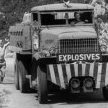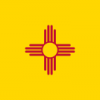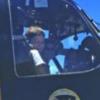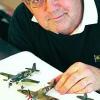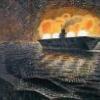

Dana Bell
Members-
Posts
382 -
Joined
-
Last visited
Profile Information
-
Gender
Male
-
Location
Arlington, Virginia
Recent Profile Visitors
5,123 profile views
Dana Bell's Achievements

Established Member (3/9)
1.2k
Reputation
-
Hi Dave, Great choice for a good looking build. Before you get too far I've a few notes that might help, some addressing your questions... - The aircraft is certainly a P-40 (AKA P-40-CU, but no model suffix). This was the only model to carry the r/w/b rudder stripes and 4-position wing insignia, with no fuselage insignia. (The 50 P-40 fuselages rebuilt as P-40Gs retained the fuselage markings, but carried only 2 wing insignia.) - The Neutral Gray camouflage came up beneath the horizontal tail for countershading. On P-40Bs and subsequent the demarcation was as shown in the decal artwork. - The Dark OD swept around the wing leading edge for a few degrees, though not as far as seen on many Navy aircraft. - The "U. S. ARMY" underwing marking was black; the marking changed to Insignia Blue on P-40Bs and subsequent. - The revised wing root fairing was added in the field and carried a slightly different shade of OD. - The aircraft was delivered with the long blast tubes for the synchronized guns. In tests the tubes flexed too much and were destroyed by the bullets trying to pass through them. As a fix, the tubes were shortened with the front trimmed at an angle. - There were no gas/oil ports in the left-side rear vision tunnel. A small hatch for the fuselage fuel tank was on the fuselage below the rear vision tunnel, and a small oil filler tank hatch was aft of the tunnel. - Hap Arnold wanted four .30s in each wing, but there was no money for the extra guns - all unsuffixed P-40s provided for installation on a single gun in each wing. - The "armored" glass (as noted above, not really armored, but at least adding some protection from rifle-caliber rounds) was eventually installed in some P-40s, but by then the markings were revised. Enjoy the build - I look forward to seeing your results! Cheers, Dana
-

Feeling out of my depth - Devastator Question
Dana Bell replied to SleeperService's topic in Aircraft WWII
Hi Sleeper, That's supposed to be the hydraulic fluid filter. Cheers, Dana -
Hi Pat, It was dragged out of the South Pacific jungles. They know who flew it, how it got there, and other details of the plane's history. Dana
-
As noted above, the paint used was Dark Olive Drab. Also as noted, the paint faded more dramatically than the exterior color, so you can gray things up a bit for your model. However, do NOT use any of the interior greens. Cheers, Dana
-
I was working at Air Force Audiovisual when the first images of the desert scheme came in - they pix were very popular, with a much more "military" appearance than the all-white test schemes. It turned out the desert colors were applied because the white scheme was ruining the test results during tests at Edwards - the aircraft was too visible during penetration tests. A short time later the Iranians took the US embassy staff hostage, and we were told to stop releasing pix with the desert camouflage - the State Department didn't want Iran to think we were planning to use the B-1 against them! At least we didn't hurt their feelings... Cheers, Dana
-

Tamiya F4U-1D Corsair Build Project
Dana Bell replied to RaisingArizona's topic in Work in Progress - Aircraft
A few quick notes on the color schemes - the aircraft #5 photo is colorized, though not unreasonably, while the NASM scheme (#56) appears to have white on the fuselage sides, better photos show that the color is actually the correct Intermediate Blue. The underside of the fuselage and wing center section is white, not Light Gray, and the underside of the outer panels will be Intermediate Blue. To break up the hard line between the center and outer wing panels, a thin overspray of Intermediate Blue carried over onto the center panel. That scheme was applied to the first (approximately) 300 -1Ds, with all subsequent production in overall Glossy Sea Blue. Looks like you're off to a great start on the kit - I look forward to your continued progress! Cheers, Dana -
Hi Tommy, There were field mixes for Light Gray and Blue Gray while the Fleet awaited factory production of the paints - that's the good news. The bad news is that I've had to put those files (aka piles of unsorted papers) to the side while I try to finish two other projects. I'll try to publish the info here once I can get back to work on the USN WW2 aviation camouflage book later this summer. Cheers, Dana
-
The "color number" has been a point of confusion for decades, but those numbers had nothing to do with the individual color values. M-485 was the Navy spec for all camouflage lacquers, including Light Gray. When Blue Gray was invented, the spec was revised, adding the new (unnumbered) color to M-485a. Camouflage dopes were listed under M-495. Some earlier publications assumed the numbers distinguished Light Gray from Blue Gray, but both unnumbered colors appeared in both specs. With the introduction of the Gull Grays in 1943, BuAer offered the following mixes: Gull Gray Dark -- ten parts Light Gray to one part Black Gull Gray Light (which became 36440) -- two parts Light Gray to one part white Cheers, Dana
-
Hi Fritz, Because of its exceedingly long nose, the Corsair was an exception and used Non-specular Sea Blue forward of the windscreen. This was standard from the factories. I can't find my factory drawings right now, but I believe the ANA 623 aircraft used Insignia Gray (a mix of Insignia White and light gray) on the upper wing insignia. Cheers, Dana
-
Hammer2023 started following Dana Bell
-

Royal Navy Corsair with added new Questions.
Dana Bell replied to Corsairfoxfouruncle's topic in Aircraft WWII
Hi all, I haven't been following this discussion very closely, but my writing is going VERY slowly today, so a break seems like a lot more fun. Part of the confusion comes from changes in BuAer planning. Because the planned introduction of the twin pylons came in the middle of a serial batch planned for the UK, BuAer moved the British block forward to allow the first twin pylon aircraft to go to the Marines. Then the twin-pylon installation was delayed and ended up in the middle of a British batch anyway. The designation/redesignation is well documented in BuAer correspondence - the first twin-pylon Corsairs were initially designated F4U-1 (or F4U-1A in the factories). The twin-plumbed pylons were then called F4U-1D by BuAer, followed shortly by the redesignation of the earlier airframes as -1Ds, followed by the plan to replumb the initial twin-pylon deliveries. There's one other issue with Corsir records, and that has to do with adjusting serial lists for contract purposes. If - for example - serial 12345 and all subsequent aircraft have modification "A, " but three earlier aircraft had that modification out of sequence (let's call them 12335, 12337, and 12340). To simplify payments, the list of aircraft with mod A would be writen as "12342 and subsequent" - even though 12342, 12343, and 12344 NEVER received mod A. As far as contracts were concerned, the correct number of aircraft with the mod were paid for, and that was all that mattered. As far as WE are concerned, there is confusion about why none of the photos of those three aircraft show that mod. Book keeping! Anyhow, my complete list is far to large to post here, but perhaps the following selection will help. The first number is the Vought serial, followed by the BuAer serial, followed by any non-US serial (with a number just to help me count Kiwi deliveries), followed by the designation (I used the -1A for clarity), followed by any notes I had from correspondence or change orders. This is the best I have on the subject - I can't guarantee perfection, but hope this will help! Cheers, Dana 2789 50324 NZ5383 F4U-1A 237 2790 50325 JT530 Corsair II this block of British serials was adjusted forward to avoid interference with first F4U-1D going to the USN, then JT555 was delivered as the first -1D 2791 50326 JT531 Corsair II 2792 50327 JT532 Corsair II 2793 50328 JT533 Corsair II 2794 50329 JT534 Corsair II 2795 50330 JT535 Corsair II 2796 50331 JT536 Corsair II 2797 50332 JT537 Corsair II 2798 50333 JT538 Corsair II 2799 50334 JT539 Corsair II 2800 50335 JT540 Corsair II 2801 50336 JT541 Corsair II 2802 50337 JT542 Corsair II 2803 50338 JT543 Corsair II 2804 50339 JT544 Corsair II 2805 50340 JT545 Corsair II 2806 50341 JT546 Corsair II 2807 50342 JT547 Corsair II 2808 50343 JT548 Corsair II 2809 50344 JT549 Corsair II 2810 50345 JT550 Corsair II 2811 50346 JT551 Corsair II 2812 50347 JT552 Corsair II 2813 50348 JT553 Corsair II 2814 50349 JT554 Corsair II 2815 50350 JT555 Corsair II eliminate outer wing fuel tanks; introduce twin pylons with fuel tank on right pylon only 2816 50351 JT556 Corsair II 2817 50352 JT557 Corsair II 2818 50353 JT558 Corsair II 2819 50354 JT559 Corsair II 2820 50355 JT560 Corsair II 2821 50356 JT561 Corsair II 2822 50357 JT562 Corsair II 2823 50358 JT563 Corsair II 2824 50359 JT564 Corsair II 2825 50360 F4U-1D first USN -1D, delivered without fuel provisions on left pylon; retrofit ordered for left pylon; tested systems at Pax, 20 Jul - 9 Sep 1944 replacing 18108 (which crashed) 2826 50361 F4U-1D 2827 50362 F4U-1D 2828 50363 F4U-1D 2829 50364 F4U-1D 2830 50365 F4U-1D 2831 50366 F4U-1D 2832 50367 F4U-1D 2833 50368 F4U-1D 2834 50369 F4U-1D 2835 50370 F4U-1D 2836 50371 F4U-1D 2837 50372 F4U-1D 2838 50373 F4U-1D 2839 50374 F4U-1D 2840 50375 F4U-1D NASM artifact 2841 50376 F4U-1D 2842 50377 F4U-1D 2843 50378 F4U-1D 2844 50379 F4U-1D 2845 50380 F4U-1D 2846 50381 NZ5460 F4U-1D 1 2847 50382 F4U-1D 2848 50383 F4U-1D 2849 50384 F4U-1D 2850 50385 F4U-1D 2851 50386 F4U-1D 2852 50387 F4U-1D 2853 50388 F4U-1D 2854 50389 F4U-1D 2855 50390 F4U-1D 2856 50391 F4U-1D 2857 50392 F4U-1D 2858 50393 F4U-1D 2859 50394 F4U-1D 2860 50395 F4U-1D 2861 50396 F4U-1D 2862 50397 F4U-1D 2863 50398 F4U-1D 2864 50399 F4U-1D 2865 50400 F4U-1D 2866 50401 F4U-1D 2867 50402 F4U-1D 2868 50403 F4U-1D 2869 50404 NZ5466 F4U-1D 2 2870 50405 NZ5397 F4U-1D 3 2871 50406 F4U-1D 2872 50407 F4U-1D 2873 50408 F4U-1D 2874 50409 F4U-1D 2875 50410 F4U-1D 2876 50411 NZ5468 F4U-1D 4 2877 50412 F4U-1D 2878 50413 F4U-1D 2879 50414 F4U-1D 2880 50415 F4U-1D 2881 50416 F4U-1D 2882 50417 F4U-1D 2883 50418 F4U-1D 2884 50419 F4U-1D 2885 50420 F4U-1D 2886 50421 F4U-1D 2887 50422 NZ5467 F4U-1D 5 2888 50423 F4U-1D 2889 50424 NZ5537 F4U-1D 6 2890 50425 NZ5538 F4U-1D 7 2891 50426 NZ5539 F4U-1D 8 2892 50427 F4U-1D 2893 50428 F4U-1D 2894 50429 F4U-1D 2895 50430 F4U-1D 2896 50431 F4U-1D 2897 50432 NZ5540 F4U-1D 9 2898 50433 F4U-1D 2899 50434 F4U-1D 2900 50435 F4U-1D 2901 50436 NZ5551 F4U-1D 10 2902 50437 F4U-1D 2903 50438 NZ5541 F4U-1D 11 2904 50439 NZ5464 F4U-1D 12 2905 50440 F4U-1D 2906 50441 F4U-1D 2907 50442 F4U-1D 2908 50443 NZ5448 F4U-1D 13 2909 50444 NZ5439 F4U-1D 14 2910 50445 NZ5552 F4U-1D 15 2911 50446 NZ5542 F4U-1D 16 2912 50447 NZ5543 F4U-1D 17 2913 50448 F4U-1D 2914 50449 NZ5443 F4U-1D 18 2915 50450 NZ5442 F4U-1D 19 2916 50451 NZ5553 F4U-1D 20 2917 50452 NZ5451 F4U-1D 21 2918 50453 NZ5544 F4U-1D 22 2919 50454 NZ5545 F4U-1D 23 2920 50455 F4U-1D 2921 50456 NZ5546 F4U-1D 24 2922 50457 NZ5547 F4U-1D 25 2923 50458 NZ5447 F4U-1D 26 2924 50459 NZ5440 F4U-1D 27 2925 50460 JT565 Corsair II 2926 50461 JT566 Corsair II 2927 50462 JT567 Corsair II 2928 50463 JT568 Corsair II 2929 50464 JT569 Corsair II 2930 50465 JT570 Corsair II 2931 50466 JT571 Corsair II 2932 50467 JT572 Corsair II 2933 50468 JT573 Corsair II 2934 50469 JT574 Corsair II 2935 50470 JT575 Corsair II 2936 50471 JT576 Corsair II 2937 50472 JT577 Corsair II 2938 50473 JT578 Corsair II 2939 50474 JT579 Corsair II 2940 50475 JT580 Corsair II 2941 50476 JT581 Corsair II 2942 50477 JT582 Corsair II 2943 50478 JT583 Corsair II 2944 50479 JT584 Corsair II 2945 50480 JT585 Corsair II 2946 50481 JT586 Corsair II 2947 50482 JT587 Corsair II 2948 50483 JT588 Corsair II 2949 50484 JT589 Corsair II 2950 50485 JT590 Corsair II 2951 50486 JT591 Corsair II 2952 50487 JT592 Corsair II 2953 50488 JT593 Corsair II 2954 50489 JT594 Corsair II 2955 50490 JT595 Corsair II 2956 50491 JT596 Corsair II 2957 50492 JT597 Corsair II 2958 50493 JT598 Corsair II 2959 50494 JT599 Corsair II 2960 50495 F4U-1D 2961 50496 F4U-1D 2962 50497 F4U-1D 2963 50498 F4U-1D 2964 50499 F4U-1D 2965 50500 F4U-1D 2966 50501 F4U-1D 2967 50502 NZ5548 F4U-1D 28 2968 50503 F4U-1D 2969 50504 F4U-1D 2970 50505 F4U-1D 2971 50506 F4U-1D 2972 50507 F4U-1D 2973 50508 F4U-1D 2974 50509 F4U-1D 2975 50510 F4U-1D 2976 50511 F4U-1D 2977 50512 F4U-1D 2978 50513 F4U-1D 2979 50514 F4U-1D 2980 50515 F4U-1D 2981 50516 F4U-1D 2982 50517 F4U-1D 2983 50518 F4U-1D 2984 50519 F4U-1D 2985 50520 F4U-1D 2986 50521 F4U-1D 2987 50522 F4U-1D 2988 50523 F4U-1D 2989 50524 F4U-1D 2990 50525 F4U-1D 2991 50526 F4U-1D 2992 50527 F4U-1D 2993 50528 F4U-1D 2994 50529 F4U-1D 2995 50530 F4U-1D 2996 50531 F4U-1D 2997 50532 F4U-1D 2998 50533 NZ5555 F4U-1D 29 2999 50534 F4U-1D 3000 50535 F4U-1D 3001 50536 F4U-1D 3002 50537 F4U-1D 3003 50538 F4U-1D 3004 50539 F4U-1D 3005 50540 NZ5549 F4U-1D 30 3006 50541 NZ5556 F4U-1D 31 3007 50542 F4U-1D 3008 50543 F4U-1D 3009 50544 F4U-1D 3010 50545 F4U-1D 3011 50546 F4U-1D 3012 50547 NZ5550 F4U-1D 32 3013 50548 NZ5557 F4U-1D 33 3014 50549 NZ5483 F4U-1D 34 3015 50550 NZ5408 F4U-1D 35 3016 50551 F4U-1D 3017 50552 F4U-1D 3018 50553 NZ5558 F4U-1D 36 3019 50554 F4U-1D 3020 50555 F4U-1D 3021 50556 NZ5559 F4U-1D 37 3022 50557 NZ5560 F4U-1D 38 3023 50558 NZ5561 F4U-1D 39 3024 50559 F4U-1D 3025 50560 NZ5429 F4U-1D 40 introduce dampening provisions for oleo struts and 3rd tail wheel door variant 3026 50561 NZ5410 F4U-1D 41 3027 50562 NZ5562 F4U-1D 42 3028 50563 NZ5419 F4U-1D 43 3029 50564 NZ5563 F4U-1D 44 3030 50565 NZ5409 F4U-1D 45 3031 50566 NZ5405 F4U-1D 46 3032 50567 NZ5564 F4U-1D 47 3033 50568 NZ5402 F4U-1D 48 3034 50569 NZ5565 F4U-1D 49 3035 50570 NZ5566 F4U-1D 50 3036 50571 F4U-1D 3037 50572 NZ5567 F4U-1D 51 3038 50573 NZ5568 F4U-1D 52 3039 50574 NZ5569 F4U-1D 53 3040 50575 JT600 Corsair II 3041 50576 JT601 Corsair II 3042 50577 JT602 Corsair II 3043 50578 JT603 Corsair II 3044 50579 JT604 Corsair II 3045 50580 JT605 Corsair II 3046 50581 JT606 Corsair II 3047 50582 JT607 Corsair II 3048 50583 JT608 Corsair II 3049 50584 JT609 Corsair II 3050 50585 JT610 Corsair II 3051 50586 JT611 Corsair II 3052 50587 JT612 Corsair II 3053 50588 JT613 Corsair II 3054 50589 JT614 Corsair II 3055 50590 JT615 Corsair II 3056 50591 JT616 Corsair II 3057 50592 JT617 Corsair II 3058 50593 JT618 Corsair II 3059 50594 JT619 Corsair II 3060 50595 JT620 Corsair II 3061 50596 JT621 Corsair II 3062 50597 JT622 Corsair II 3063 50598 JT623 Corsair II 3064 50599 JT624 Corsair II 3065 50600 JT625 Corsair II 3066 50601 JT626 Corsair II 3067 50602 JT627 Corsair II 3068 50603 JT628 Corsair II 3069 50604 JT629 Corsair II 3070 50605 JT630 Corsair II 3071 50606 JT631 Corsair II 3072 50607 JT632 Corsair II 3073 50608 JT633 Corsair II 3074 50609 JT634 Corsair II 3075 50610 NZ5570 F4U-1D 54 delete all outer panel fuel tank provisions 3076 50611 NZ5571 F4U-1D 55 3077 50612 NZ5572 F4U-1D 56 3078 50613 F4U-1D 3079 50614 F4U-1D 3080 50615 F4U-1D 3081 50616 F4U-1D 3082 50617 F4U-1D 3083 50618 NZ5573 F4U-1D 57 3084 50619 F4U-1D 3085 50620 F4U-1D 3086 50621 F4U-1D 3087 50622 F4U-1D 3088 50623 NZ5574 F4U-1D 58 3089 50624 F4U-1D 3090 50625 F4U-1D 3091 50626 F4U-1D Cherry Point K-25A camera installation 3092 50627 F4U-1D 3093 50628 F4U-1D 3094 50629 F4U-1D 3095 50630 F4U-1D 3096 50631 F4U-1D 3097 50632 F4U-1D 3098 50633 F4U-1D Cherry Point K-25A camera installation 3099 50634 F4U-1D 3100 50635 NZ5575 F4U-1D 59 3101 50636 F4U-1D 3102 50637 F4U-1D 3103 50638 NZ5399 F4U-1D 60 3104 50639 F4U-1D 3105 50640 NZ5576 F4U-1D 61 introduce fuel tank provisions for left hand pylon 3106 50641 F4U-1D 3107 50642 F4U-1D 3108 50643 F4U-1D 3109 50644 NZ5449 F4U-1D 62 3110 50645 F4U-1D 3111 50646 NZ5450 F4U-1D 63 3112 50647 NZ5400 F4U-1D 64 3113 50648 F4U-1D 3114 50649 F4U-1D 3115 50650 F4U-1D 3116 50651 F4U-1D 3117 50652 F4U-1D Cherry Point K-25A camera installation 3118 50653 NZ5434 F4U-1D 65 3119 50654 NZ5431 F4U-1D 66 3120 50655 F4U-1D 3121 50656 NZ5433 F4U-1D 67 3122 50657 F4U-1D 3123 50658 NZ5411 F4U-1D 68 3124 50659 NZ5406 F4U-1D 69 delete center section filler and surfacing BuNo Range – 57084 thru 57983 3125 57084 F4U-1D planned introduction of fuel tanks on each pylon, but this occurred on 50640. Introduce GSB finish and cutout in rear edge of canopy; delete fuel provisions for CL tank; Cherry Point K-25A camera installation 3126 57085 F4U-1D 3127 57086 F4U-1D 3128 57087 F4U-1D 3129 57088 NZ5446 F4U-1D 70 3130 57089 NZ5407 F4U-1D 71 3131 57090 NZ5404 F4U-1D 72 3132 57091 F4U-1D Cherry Point K-25A camera installation 3133 57092 NZ5415 F4U-1D 73- 57 replies
-
- 6
-

-

-
- Squadron & markings
- Corsair IV
-
(and 1 more)
Tagged with:
-
You folks are way too kind! A simple note that I'm up to the gunwales brings a bunch of positive responses. Small wonder I love it here... On the upside, my next Rivet Counter Guide is on track for late February. I'll not sneak in an ad mby listing the title, but I should be sending in a review copy as soon as it's delivered. Cheers, Dana
-
Hi folks, I've been pretty unresponsive for several months - lots of work and little time, followed by a recent, small explosion in my computer. I'm slowly getting back in touch, and I'll try to get back to everyone about your queries, but I'm now farther behind than I was. I appreciate your patience - more soon... Cheers, Dana
- 10 replies
-
- 35
-

-

-

Vought Kingfisher ‒ A veritable 'Salty Sea Dog'
Dana Bell replied to Toryu's topic in The Salty Sea Dog GB
Hi Toryu, I've wondered about the attribution of that aircraft for a long time - while I don't know with certainty, I'm pretty sure we're looking at an aircraft from CruDiv One, VCS-1. The division comprised Detroit, Raleigh, and Richmond and was stationed in Alaskan waters for most of 1943. The photo shows our plane launching from an Omaha-class cruiser, but I can't tell which one. Detroit was supposed to be flagship and should have carried aircraft 1 and 2 -- if this is Detroit, I don't have a clear explanation of why Aircraft 3 ws on board. The scheme appears to be the Sea Blues and Intermediate Blue over the original Light Gray -- an odd but not impossible combination. The national insignias still have the red borders (no blue repaint yet), and I can be confirm that this is the same aircraft as seen in the well known color shot in Alaska. For fun, remember that this image was taken around the time field units complained that the blues were bleaching out of their Intermediate Blue paints leaving only red and white pigments - leaving a nice pink appearance. With as much bleaching as we're seeing here, a pink and blue Kingfisher could be very attractive! Cheers, Dana -

pic of u.s. c-47 WW II with OD camo ruined/lived
Dana Bell replied to Davide Calzolari's topic in Aircraft WWII
Hi Phoenix, Yes, it was a slide. We were going through a batch of several hundred slides, including about a dozen that were from this series. I don't recall the film type - it was more than 25 years ago - but I like this one enough to get a first generation dupe. Cheers, Dana

